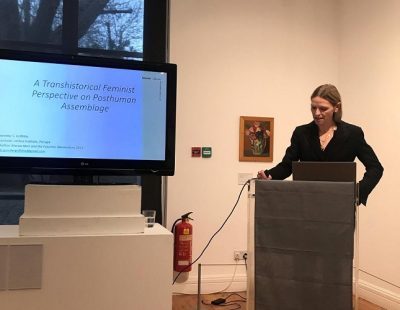Umbra Art History Professor Presents on Futurism

Most people think of Italian Futurism as a man’s movement. Even at Palazzo Strozzi’s retrospective on Natalia Goncharova the curators announced in wall text: “Futurism admitted no women.” Marinetti’s 1909 Founding Manifesto indeed declared a “scorn for women,” but a lot of women artists and writers were attracted to its rebellious program that rejected many traditional gender stereotypes and surprisingly encouraged women to join them. Umbra Institute lecturer Dr. Jennifer Griffiths rethinks these women.
This past week Professor Griffiths presented some recent research on Futurism’s legacy at an international symposium hosted by the prestigious Estorick Collection of Modern Italian Art, London. By understanding this Italian avant-garde movement as male-dominated and misogynistic, by neglecting the work of women Futurists, and by assuming a link between Marinetti’s rhetoric of toxic masculinity and technology, scholars have ignored an alternative legacy of Futurism, which allowed women to reimagine their bodies and opened a window onto posthuman refashions of our bodies via technology, e.g. prosthetics, surgery, and even mechanical wombs. In her talk entitled “A Transhistorical Feminist Perspective on Posthuman Assemblage,” Griffiths discussed how various female Futurists saw the movement and its optimistic embrace of technology as liberatory. “By studying Futurism from the margins, a very different liberatory genealogy appears that prefigures the feminist theories of Simone de Beauvoir and Rosi Braidotti,” said Griffiths.
At Umbra, Professor Griffiths teaches courses in art history, gender studies, and environmental studies. Her newest course, Green Art: The Aesthetics, Ethics, and Politics of Creativity in Today’s World, explores ecology, environmental art, and the possibilities of achieving more ethical and sustainable political futures through creativity.